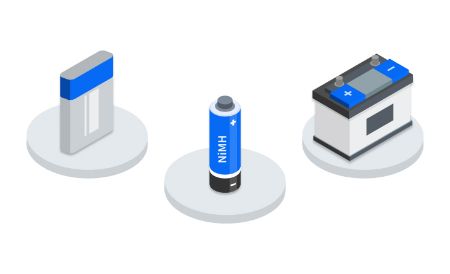Batteries are used by electrical engineers and non-electrical engineers alike. The requirements for electrical engineers and their electronics projects tend to be more demanding than those of the average person. However, sometimes, there are situations when people who are not intimately familiar with batteries as a power source or power supply need to find the perfect solution. In this article, we’ll discuss the biggest considerations when buying a battery to make sure it fits exactly what you’re looking for.
While many different features of a battery may be flexible, the voltage output is usually a rigid requirement. If a project specifies a certain voltage, there is generally very little ambiguity or flexibility in that. To make things more interesting, the voltage output of batteries changes as they discharge. To simplify matters, batteries are often rated with their nominal voltage. The ubiquitous single-cell lithium-ion battery is often quoted as being 3.7VDC but, in reality, its output ranges between 3.7V and 4.2V.
Another crucial factor to consider is the current or power output of the battery. Every electronic project has a minimum current requirement, and using a battery that cannot supply sufficient current can lead to unreliable performance or even outright failure. This is called the “discharge rate”, often expressed as the C-rating of a battery. This specification determines how quickly a battery can safely deliver its stored energy. A battery with a low discharge rate might work fine for steady, low-power applications but would struggle with high-power bursts required by motors or other demanding loads. Some batteries are designed for low-current applications, such as small sensors or remote controls, while others can handle high-drain loads, like power tools or drones. Before purchasing a battery, it’s essential to verify that it can consistently supply at least the minimum required current for your application. Also, the discharge and charge rates are proportionally related, so if a battery has a high C-rating, it can usually be recharged quickly as well. That said, a battery with a higher C-rating or power output than required is generally acceptable and even beneficial. As long as it meets the minimum, it will work and having some spare capacity is nice if you can spare it.
Alongside power output, battery capacity is another critical consideration. Measured in milliamp-hours (mAh) or amp-hours (Ah), battery capacity indicates how long a battery can supply a given amount of current before it needs to be recharged or replaced. If a project requires a device to run for extended periods without recharging, opting for a higher-capacity battery can be beneficial. However, high-capacity batteries often come at the cost of increased size and weight, which can be limiting depending on the project’s design constraints. You’ll also find that primary batteries are often more energy-dense, meaning they can store more energy than a rechargeable battery of the same size.
Next, there’s battery chemistry. Different chemistries offer distinct trade-offs in terms of energy density, rechargeability, safety, and longevity. Common options include lithium-ion (high energy density and rechargeable), lithium-polymer (lightweight and flexible but more delicate), nickel-metal hydride (NiMH, a good rechargeable alternative to disposable alkaline batteries), and lead-acid (heavy but powerful and cost-effective for large applications). There are also many non-rechargeable choices that are more energy-dense with lower self-discharge rates that may be perfect for those applications that need to last a very long time with only the smallest trickle of usage. Thus, the choice of chemistry depends on the balance of performance, safety, design needs, and cost that best suits the intended use case.
Beyond chemistry, size, weight, and rechargeability are also key factors, especially in portable applications. While a lot of focus is on rechargeable batteries because they are so common nowadays, primary batteries may be the correct solution. A battery that’s too large or heavy may be impractical, while a non-rechargeable battery could be costly and inconvenient for long-term use. Even among rechargeable applications, some applications prioritize compact, lightweight batteries, such as wearables or drones, whereas others, like uninterruptible power supplies, may require larger, heavier batteries. The decision should be guided by both technical needs and practical constraints.
Finally, for projects operating in challenging environments, ruggedness and survivability is an important consideration. Some batteries are built to withstand extreme temperatures, moisture, vibration, or impact, making them ideal for outdoor, industrial, or military applications. If a battery will be exposed to harsh conditions, it’s crucial to choose one with appropriate durability ratings to ensure reliable performance over time without catastrophic failure.
By carefully considering these factors - voltage, capacity, discharge rate, chemistry, size, weight, rechargeability, and ruggedness - you can ensure that the battery you select will meet the demands of your specific project. Whether you’re powering a simple sensor or a complex robotic system, understanding these key attributes will help you find the perfect power source to keep your electronics running efficiently and reliably.
kontakt
 English
English
 Chinese
Chinese
 Italiano
Italiano
 Portuguese
Portuguese
 Deutschland
Deutschland
 French
French
 Russian
Russian
 Japanese
Japanese
 Turkish
Turkish
 Korean
Korean
 Spanish
Spanish

